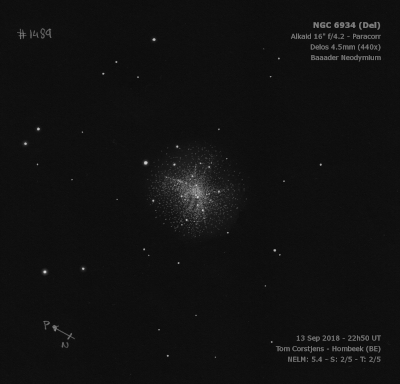
William Herschel discovered NGC 6934 = H I-103 = h2081 on 24 Sep 1785 (sweep 440) and recorded "vB, L, gmbM, er. A beautiful object." His position is 36 sec of RA too far west and 7' too far north. The large error was apparently the result of using "a new Polar distance machine contrived to shew the polar distance of the tube in every situation" that was not finished. JH called it "A beautiful, v compressed, B, R, globular cluster, 3' diam, well resolved. Stars = 16...20m." On 19 Aug 1855, R.J. Mitchell (LdR's assistant) recorded "very fine glob Cl, comes up to a blaze in centre. From f side of Nucl a stream of stars runs np, rather brighter and more condensed than in the rest of the border."
200/250mm - 8" (6/29/84): mottled, fainter halo, clumpy at 400x but no resolution.
300/350mm - 13.1" (6/29/84): fairly bright, moderately large, bright core, small outer halo resolved into approximately 15 stars mainly south of the core, mottled. A mag 9 star is 2' W.
400/500mm - 17.5" (8/5/94): bright, 3.0' diameter, round. Fairly sharp concentration with a 1.5' diameter very bright core. The halo has about two dozen stars peppered in the outer regions; the brightest star is on the NE side of the core. The core is very lively and just starts to break up in to several very faint stars and a single obvious star. A mag 9.5 star is just 2' W of center.
17.5" (7/9/94): bright, fairly small, 3.5' diameter, very bright core. At 225x, 20-25 stars are resolved in the halo mostly in the southern portion. Contains an intense 1.5' core with a much fainter halo to 3.5' which extends almost to a mag 9.5 star 2' W of center. The bright core itself is very lively and mottled with a few faint stars resolved and a single brighter star just east of the geometric center.
Notes by Steve Gottlieb